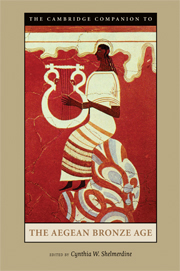Book contents
- Frontmatter
- 1 Background, Sources, and Methods
- 2 The Early Bronze Age in Greece
- 3 The Early Bronze Age in the Cyclades
- 4 Early Prepalatial Crete
- 5 Protopalatial Crete
- 6 The Material Culture of Neopalatial Crete
- 7 Minoan Culture: Religion, Burial Customs, and Administration
- 8 Minoan Crete and the Aegean Islands
- 9 Minoan Trade
- 10 Early Mycenaean Greece
- 11 Mycenaean Art and Architecture
- 12 Mycenaean States
- 13 Burial Customs and Religion
- 14 Mycenaean Greece, the Aegean and Beyond
- 15 Decline, Destruction, Aftermath
- Glossary
- Select Bibliography
- Index
- Plate section
8 - Minoan Crete and the Aegean Islands
Published online by Cambridge University Press: 28 November 2010
- Frontmatter
- 1 Background, Sources, and Methods
- 2 The Early Bronze Age in Greece
- 3 The Early Bronze Age in the Cyclades
- 4 Early Prepalatial Crete
- 5 Protopalatial Crete
- 6 The Material Culture of Neopalatial Crete
- 7 Minoan Culture: Religion, Burial Customs, and Administration
- 8 Minoan Crete and the Aegean Islands
- 9 Minoan Trade
- 10 Early Mycenaean Greece
- 11 Mycenaean Art and Architecture
- 12 Mycenaean States
- 13 Burial Customs and Religion
- 14 Mycenaean Greece, the Aegean and Beyond
- 15 Decline, Destruction, Aftermath
- Glossary
- Select Bibliography
- Index
- Plate section
Summary
Introduction
The nature of Minoan involvement in the Aegean islands is an intrinsically fascinating question for a prehistorian of Greece, one that has been debated since the very beginning of our field. It also constitutes an excellent case study of broader interest in world archaeology. What causes promote the cultural assimilation of one group by another? How do the opposing forces of socio-economic domination and resistance manifest themselves in material culture? For at the beginning of the Late Bronze Age, the communities of the Cyclades and of other islands of the Aegean Sea were so radically altered by contact with the Minoan civilization that scarcely an aspect of life in them was left unaffected. As for the field of Aegean prehistory in general, fundamental research questions that concern Minoan Crete and the Aegean islands have often been framed in response to testimonia preserved in Greek texts of the historical period. Literary sources are thus an aspect of the problem that deserves attention before we consider archaeological data.
In the following section, therefore, we will first review the ancient written tradition. Then we will examine the actual archaeological evidence, as it has been uncovered at several representative and well known sites in Greece and western Turkey. Finally we will turn to the reasons that Cretans may have been attracted to the Cycladic and Dodecanesian islands, and to their impact on these areas.
- Type
- Chapter
- Information
- The Cambridge Companion to the Aegean Bronze Age , pp. 186 - 208Publisher: Cambridge University PressPrint publication year: 2008
- 11
- Cited by

